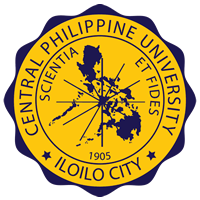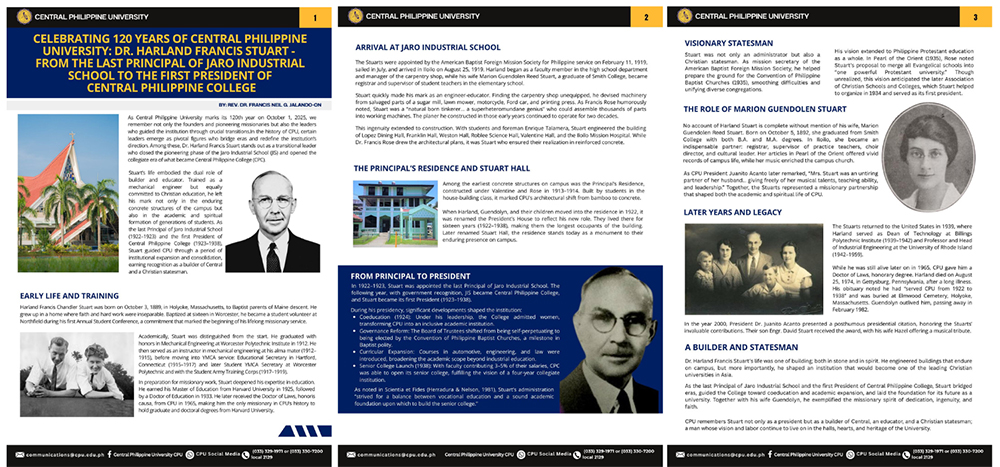Rev. Dr. Francis Neil G. Jalando-on
CPU marks its 120th year by honoring Dr. Harland Francis Stuart, the visionary leader who bridged the Jaro Industrial School and Central Philippine College, guiding the institution through growth, innovation, and faith.
As Central Philippine University marks its 120th year on October 1, 2025, we remember not only the founders and pioneering missionaries but also the leaders who guided the institution through crucial transitions. In the history of CPU, certain leaders emerge as pivotal figures who bridge eras and redefine the institution’s direction. Among these, Dr. Harland Francis Stuart stands out as a transitional leader who closed the pioneering phase of the Jaro Industrial School (JIS) and opened the collegiate era of what became Central Philippine College (CPC).
Stuart’s life embodied the dual role of builder and educator. Trained as a mechanical engineer but equally committed to Christian education, he left his mark not only in the enduring concrete structures of the campus but also in the academic and spiritual formation of generations of students. As the last Principal of Jaro Industrial School (1922–1923) and the first President of Central Philippine College (1923–1938), Stuart guided CPU through a period of institutional expansion and consolidation, earning recognition as a builder of Central and a Christian statesman.
Early Life and Training
Harland Francis Chandler Stuart was born on October 3, 1889, in Holyoke, Massachusetts, to Baptist parents of Maine descent. He grew up in a home where faith and hard work were inseparable. Baptized at sixteen in Worcester, he became a student volunteer at Northfield during his first Annual Student Conference, a commitment that marked the beginning of his lifelong missionary service.
Academically, Stuart was distinguished from the start. He graduated with honors in Mechanical Engineering at Worcester Polytechnic Institute in 1912. He then served as an instructor in mechanical engineering at his alma mater (1912–1915), before moving into YMCA service: Educational Secretary in Hartford, Connecticut (1915–1917) and later Student YMCA Secretary at Worcester Polytechnic and with the Student Army Training Corps (1917–1919).
In preparation for missionary work, Stuart deepened his expertise in education. He earned his Master of Education from Harvard University in 1925, followed by a Doctor of Education in 1933. He later received the Doctor of Laws, honoris causa, from CPU in 1965, making him the only missionary in CPU’s history to hold graduate and doctoral degrees from Harvard University.
Arrival at Jaro Industrial School
The Stuarts were appointed by the American Baptist Foreign Mission Society for Philippine service on February 11, 1919, sailed in July, and arrived in Iloilo on August 25, 1919. Harland began as a faculty member in the high school department and manager of the carpentry shop, while his wife Marion Guendolen Reed Stuart, a graduate of Smith College, became registrar and supervisor of student teachers in the elementary school.
Stuart quickly made his mark as an engineer-educator. Finding the carpentry shop unequipped, he devised machinery from salvaged parts of a sugar mill, lawn mower, motorcycle, Ford car, and printing press. As Francis Rose humorously noted, Stuart was a “natural born tinkerer… a superheteromundane genius” who could assemble thousands of parts into working machines. The planer he constructed in those early years continued to operate for two decades.
This ingenuity extended to construction. With students and foreman Enrique Talamera, Stuart engineered the building of Lopez Dining Hall, Franklin Hall, Weston Hall, Roblee Science Hall, Valentine Hall, and the Iloilo Mission Hospital. While Dr. Francis Rose drew the architectural plans, it was Stuart who ensured their realization in reinforced concrete.
The Principal’s Residence and Stuart Hall
Among the earliest concrete structures on campus was the Principal’s Residence, constructed under Valentine and Rose in 1913–1914. Built by students in the house-building class, it marked CPU’s architectural shift from bamboo to concrete.
When Harland, Guendolyn, and their children moved into the residence in 1922, it was renamed the President’s House to reflect his new role. They lived there for sixteen years (1922–1938), making them the longest occupants of the building. Later renamed Stuart Hall, the residence stands today as a monument to their enduring presence on campus.
From Principal to President
In 1922–1923, Stuart was appointed the last Principal of Jaro Industrial School. The following year, with government recognition, JIS became Central Philippine College, and Stuart became its first President (1923–1938).
During his presidency, significant developments shaped the institution:
- Coeducation (1924): Under his leadership, the College admitted women, transforming CPU into an inclusive academic institution.
- Governance Reform: The Board of Trustees shifted from being self-perpetuating to being elected by the Convention of Philippine Baptist Churches, a milestone in Baptist polity.
- Curricular Expansion: Courses in automotive, engineering, and law were introduced, broadening the academic scope beyond industrial education.
- Senior College Launch (1938): With faculty contributing 3–5% of their salaries, CPC was able to open its senior college, fulfilling the vision of a four-year collegiate institution.
As noted in Scientia et Fides (Herradura & Nelson, 1981), Stuart’s administration “strived for a balance between vocational education and a sound academic foundation upon which to build the senior college.”
Visionary Statesman
Stuart was not only an administrator but also a Christian statesman. As mission secretary of the American Baptist Foreign Mission Society, he helped prepare the ground for the Convention of Philippine Baptist Churches (1935), smoothing difficulties and unifying diverse congregations.
His vision extended to Philippine Protestant education as a whole. In Pearl of the Orient (1935), Rose noted Stuart’s proposal to merge all Evangelical schools into “one powerful Protestant university.” Though unrealized, this vision anticipated the later Association of Christian Schools and Colleges, which Stuart helped to organize in 1934 and served as its first president.
The Role of Marion Guendolen Stuart
No account of Harland Stuart is complete without mention of his wife, Marion Guendolen Reed Stuart. Born on October 5, 1892, she graduated from Smith College with both B.A. and M.A. degrees. In Iloilo, she became an indispensable partner: registrar, supervisor of practice teachers, choir director, and cultural leader. Her articles in Pearl of the Orient offered vivid records of campus life, while her music enriched the campus church.
As CPU President Juanito Acanto later remarked, “Mrs. Stuart was an untiring partner of her husband… giving freely of her musical talents, teaching ability, and leadership.” Together, the Stuarts represented a missionary partnership that shaped both the academic and spiritual life of CPU.
Later Years and Legacy
The Stuarts returned to the United States in 1939, where Harland served as Dean of Technology at Billings Polytechnic Institute (1939–1942) and Professor and Head of Industrial Engineering at the University of Rhode Island (1942–1959).
While he was still alive later on in 1965, CPU gave him a Doctor of Laws, honorary degree. Harland died on August 25, 1974, in Gettysburg, Pennsylvania, after a long illness. His obituary noted he had “served CPU from 1922 to 1938” and was buried at Elmwood Cemetery, Holyoke, Massachusetts. Guendolyn outlived him, passing away in February 1982.
In the year 2000, President Dr. Juanito Acanto presented a posthumous presidential citation, honoring the Stuarts’ invaluable contributions. Their son Engr. David Stuart received the award, with his wife Hazel offering a musical tribute.
A Builder and Statesman
Dr. Harland Francis Stuart’s life was one of building; both in stone and in spirit. He engineered buildings that endure on campus, but more importantly, he shaped an institution that would become one of the leading Christian universities in Asia.
As the last Principal of Jaro Industrial School and the first President of Central Philippine College, Stuart bridged eras, guided the College toward coeducation and academic expansion, and laid the foundation for its future as a university. Together with his wife Guendolyn, he exemplified the missionary spirit of dedication, ingenuity, and faith.
CPU remembers Stuart not only as a president but as a builder of Central, an educator, and a Christian statesman; a man whose vision and labor continue to live on in the halls, hearts, and heritage of the University.
References
Acanto, J. M. (2000). Presidential citation for Dr. and Mrs. Harland Francis Stuart. The Link, 35(2), 6.
CPU Wall of Remembrance. (2004). Awardee’s Information Sheet.
Golden Jubilee 1905-1955. (1955). Souvenir Program. CPU.
Herradura, R., & Nelson, W. (1981). Scientia et Fides: The story of Central Philippine University. Iloilo City: Central Philippine University.
Nequin, U. F. (1955). Harland Francis Stuart: Principal, Jaro Industrial School, 1922–1923; President, Central Philippine College, 1923–1938. In Golden Jubilee Year 1905–1955 (pp. 58–59). Iloilo City: Central Philippine University.
Rose, F. H. (1935). Meet Dr. Harland Stuart. Pearl of the Orient, 32(4), 25–26.
Stuart, H. F. C. (1933–1937). Selected writings. Pearl of the Orient.

